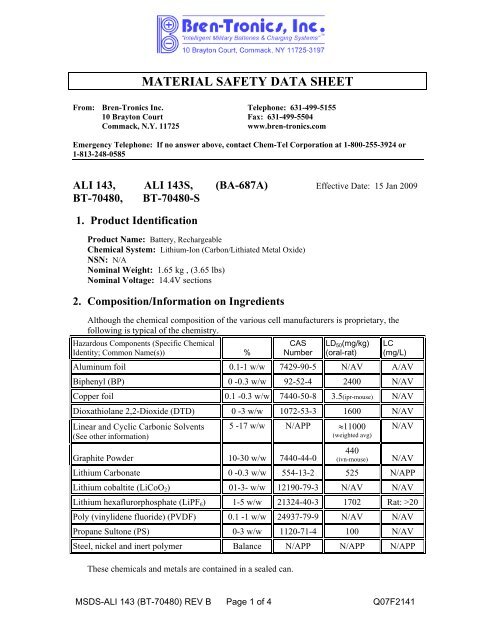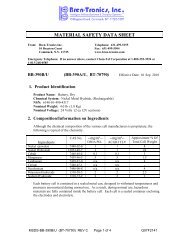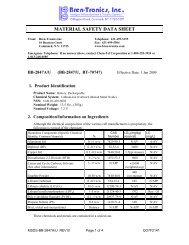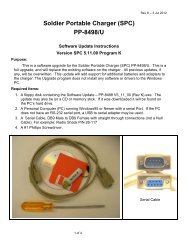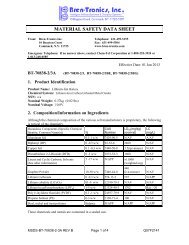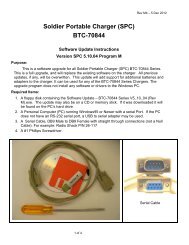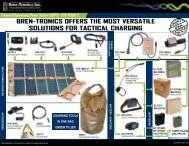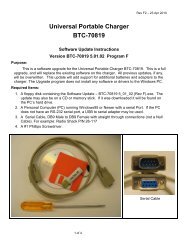MSDS - Bren-Tronics Inc.
MSDS - Bren-Tronics Inc.
MSDS - Bren-Tronics Inc.
Create successful ePaper yourself
Turn your PDF publications into a flip-book with our unique Google optimized e-Paper software.
MATERIAL SAFETY DATA SHEET<br />
From: <strong>Bren</strong>-<strong>Tronics</strong> <strong>Inc</strong>. Telephone: 631-499-5155<br />
10 Brayton Court Fax: 631-499-5504<br />
Commack, N.Y. 11725<br />
www.bren-tronics.com<br />
Emergency Telephone: If no answer above, contact Chem-Tel Corporation at 1-800-255-3924 or<br />
1-813-248-0585<br />
ALI 143, ALI 143S, (BA-687A) Effective Date: 15 Jan 2009<br />
BT-70480, BT-70480-S<br />
1. Product Identification<br />
Product Name: Battery, Rechargeable<br />
Chemical System: Lithium-Ion (Carbon/Lithiated Metal Oxide)<br />
NSN: N/A<br />
Nominal Weight: 1.65 kg , (3.65 lbs)<br />
Nominal Voltage: 14.4V sections<br />
2. Composition/Information on Ingredients<br />
Although the chemical composition of the various cell manufacturers is proprietary, the<br />
following is typical of the chemistry.<br />
Hazardous Components (Specific Chemical<br />
Identity; Common Name(s)) %<br />
CAS<br />
Number<br />
LD 50 (mg/kg)<br />
(oral-rat)<br />
LC<br />
(mg/L)<br />
Aluminum foil 0.1-1 w/w 7429-90-5 N/AV A/AV<br />
Biphenyl (BP) 0 -0.3 w/w 92-52-4 2400 N/AV<br />
Copper foil 0.1 -0.3 w/w 7440-50-8 3.5(ipr-mouse) N/AV<br />
Dioxathiolane 2,2-Dioxide (DTD) 0 -3 w/w 1072-53-3 1600 N/AV<br />
Linear and Cyclic Carbonic Solvents<br />
(See other information)<br />
5 -17 w/w N/APP ≈11000<br />
(weighted avg)<br />
Graphite Powder 10-30 w/w 7440-44-0<br />
440<br />
(ivn-mouse)<br />
N/AV<br />
N/AV<br />
Lithium Carbonate 0 -0.3 w/w 554-13-2 525 N/APP<br />
Lithium cobaltite (LiCoO 2 ) 01-3- w/w 12190-79-3 N/AV N/AV<br />
Lithium hexaflurorphosphate (LiPF 6 ) 1-5 w/w 21324-40-3 1702 Rat: >20<br />
Poly (vinylidene fluoride) (PVDF) 0.1 -1 w/w 24937-79-9 N/AV N/AV<br />
Propane Sultone (PS) 0-3 w/w 1120-71-4 100 N/AV<br />
Steel, nickel and inert polymer Balance N/APP N/APP N/APP<br />
These chemicals and metals are contained in a sealed can.<br />
<strong>MSDS</strong>-ALI 143 (BT-70480) REV B Page 1 of 4 Q07F2141
3. Hazards Identification<br />
Routes of Entry:<br />
Inhalation<br />
Skin<br />
Ingestion<br />
Not anticipated. Respiratory (and eye) irritation may occur if fumes are<br />
released due to heat or an abundance of leaking batteries.<br />
Yes<br />
Yes<br />
Potential Health Effects:<br />
These chemicals are contained in a sealed can. Risk of exposure occurs only if the<br />
battery is mechanically or electrically abused. The most likely risk is acute exposure<br />
when a cell vents. Propylene Carbonate is mildly irritating upon eye and skin contact.<br />
Contact of electrolyte and extruded lithium with skin and eyes should be avoided.<br />
Inhalation or ingestion of lithium trifluoromethane sulfonate may be harmful.<br />
Signs/Symptoms of Exposure:<br />
Skin and eye irritation may occur following exposure to a leaking battery.<br />
Medical Conditions Generally Aggravated by Exposure:<br />
An acute exposure will not generally aggravate any medical condition.<br />
4. First Aid Measures<br />
Emergency & First Aid Procedures:<br />
If battery is leaking and material contacts eyes, flush with copious amounts of clear,<br />
tepid water for thirty (30) minutes, exposed skin for at least fifteen (15) minutes.<br />
Contact Physician at once. Leaking contents may be irritating to respiratory passages.<br />
Remove to fresh air. Contact physician if irritation persists. If ingested, rinse mouth<br />
and surrounding area with clear, tepid water for at least fifteen (15) minutes. Consult<br />
physician immediately for treatment and to rule out involvement of the esophagus and<br />
other tissues.<br />
5. Fire Fighting Measures<br />
Extinguishing Media:<br />
Water spray, Carbon Dioxide, dry chemical powder or appropriate foam. Use agent appropriate for<br />
surrounding materials<br />
Special Fire Fighting Procedures:<br />
If large quantities are burning, wear self-contained breathing apparatus and protective clothing to prevent<br />
contact with skin and eyes.<br />
Unusual Fire and Explosion Hazards:<br />
Organic components will burn if cell incinerated. Combustion of cell contents will cause evolution of<br />
extremely corrosive Hydrogen Fluoride gas.<br />
6. Accidental Release Measures<br />
Ventilation:<br />
None under normal use conditions.<br />
Protective Gloves:<br />
None under normal use conditions. Use butyl gloves when handling leaking batteries.<br />
Eye Protection:<br />
None under normal use conditions. Wear safety glasses when handling leaking<br />
batteries.<br />
<strong>MSDS</strong>-ALI 143 (BT-70480) REV B Page 2 of 4 Q07F2141
7. Handling and Storage<br />
Precautions to be Taken in Handling and Storage:<br />
Store batteries in a cool (below 70° F), dry area that is subject to little temperature<br />
changes. Do not place near heating equipment, nor expose to direct sunlight for long<br />
periods. Elevated temperatures can result in reduced battery service life.<br />
Other Precautions:<br />
Do not diseassemble battery or battery pack. Do not puncture, crush or dispose of in fire.<br />
8. Exposure Controls/Personal Protection<br />
Steps to be Taken in Case Material is Released or Spilled:<br />
Notify safety personnel of large spills. Evacuate the area and allow vapors to dissipate.<br />
<strong>Inc</strong>rease ventilation. Avoid eye or skin contact. DO NOT inhale vapors. Clean up<br />
personnel should wear appropriate protective gear. Remove spilled liquid with<br />
absorbent and contain for disposal.<br />
Transport containers outdoors. Hold burned cells and fire cleanup solids for disposal as<br />
Potential hazardous waste. Unburned cells are not hazardous waste. A fire with over 100 kg of cells burnt<br />
will likely require reporting to environmental offices. Always consult and obey all international, federal<br />
and local environmental laws.<br />
9. Physical and Chemical Properties<br />
Appearance:<br />
Rectangular box shape<br />
10. Stability and Reactivity<br />
Stability:<br />
Stable<br />
Conditions to Avoid:<br />
Do not heat, crush, disassemble, short-circuit or recharge.<br />
Hazardous Decomposition or By-products:<br />
Thermal degradation may produce hazardous fumes of manganese and lithium;<br />
hydrofluoric acid; oxides of carbon and sulfur and other toxic by-products.<br />
Hazardous Polymerization:<br />
Will not occur.<br />
<strong>Inc</strong>ompatible Materials:<br />
Contents incompatible with strong oxidizing agents.<br />
11. Toxicological Information<br />
Carcinogenicity: NTP IARC Monograph OSHA Regulated<br />
No No No<br />
12. Ecological Information N/A<br />
13. Disposal Considerations<br />
Batteries must be completely discharged prior to disposal and/or the terminals must be taped or capped to<br />
prevent short circuit.<br />
Disposal of large quantities of batteries containing lithium cells may be subject to Federal, State or local<br />
regulations.<br />
<strong>MSDS</strong>-ALI 143 (BT-70480) REV B Page 3 of 4 Q07F2141
14. Transport Information<br />
Transportation: Equivalent Lithium Content, (ELC), per battery is 17.28g. The Watt-hour rating is 208 Wh.<br />
The battery and component cells have been tested and found to conform to UN T1-T8 test requirements. The<br />
battery must be transported according to the following regulations:<br />
Domestic Transportation within the U.S./ 49 CFR Section 173.185:<br />
Via ground only (motor vehicle):<br />
Excepted battery, no special packaging required other than: For quantities 13 and larger in one box, mark<br />
“LITHIUM-ION BATTERIES INSIDE" on the box and that special procedures should be followed if package<br />
is damaged. Waybill document to indicate same information. Maximum gross weight of the package is 30Kg<br />
(66lbs) and the package must be capable of being dropped 1.2 meters in any orientation without causing battery<br />
short circuits and without release of package contents.<br />
The box is to carry additional label: “LITHIUM-ION BATTERIES - FORBIDDEN FOR TRANSPORT<br />
ABOARD AIRCRAFT AND VESSEL” (with letters 0.5” ht minimum).<br />
Via air or cargo vessel:<br />
Batteries must be shipped as Class 9 Dangerous Goods with required UN specification packaging, labels,<br />
marking, and shipper’s declaration for dangerous goods. Batteries conform to UN T1-T8 test requirements.<br />
Proper shipping classification is UN 3090, Lithium Batteries, Class 9, Packing Group II.<br />
International Transportation: ADR, IMDG Code, IATA Dangerous Goods Regulations:<br />
Batteries must be shipped as Class 9 Dangerous Goods with required UN specification packaging, labels,<br />
marking, and shipper’s declaration for dangerous goods. Batteries conform to UN T1-T8 test requirements.<br />
Proper shipping classification is UN 3480, Lithium Ion Batteries, Class 9, Packing Group II. Classification for<br />
batteries packed with or packed in equipment is UN 3481.<br />
15. Regulatory Information<br />
Batteries are considered to be “articles” and thus are exempt from TSCA regulation.<br />
16. Other Information<br />
Avoid mechanical or electrical abuse. DO NOT short circuit or install incorrectly. Batteries may explode,<br />
pyrolize or vent if disassembled, crushed, recharged incorrectly or exposed to high temperatures. Install<br />
batteries in accordance with equipment instructions.<br />
_____________________________________________________________________________________<br />
This information and recommendations set forth are made in good faith and believed to be accurate as of the date of<br />
preparation. <strong>Bren</strong>-<strong>Tronics</strong> <strong>Inc</strong>. makes no warranty, expressed or implied, regarding the accuracy of the data or the<br />
results to be obtained from the use thereof.<br />
<strong>MSDS</strong>-ALI 143 (BT-70480) REV B Page 4 of 4 Q07F2141


